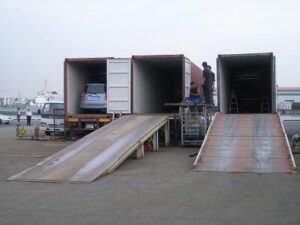Category Archives: Expedited Shipping
How to Transport a 40-Foot Boat?
Are you planning on transporting a 40-foot boat? A daunting task, yet it can be done! Before you begin, there are several steps you must consider Expedited Shipping.
From selecting the proper transport method to planning your route and budgeting for costs, there are plenty of things to consider before you set off.
Selecting the Right Transport Method
When transporting a 40-foot boat, it is essential first to consider the available transport methods. Different transportation methods may be preferable depending on the boat’s size and weight. When selecting the right method, the following questions should be considered:
* Are there any restrictions on the type of transport?
* Is the boat being transported in-state or long-distance?
* What is the size and weight of the boat, and how does it need to be secured during transport?
The most common methods for in-state transport are by road and by water. If the boat is too large to be towed by a motor vehicle, a semi-truck may be required. However, water is the preferred option if the boat needs to be transported over long distances. Boats can be transported over long distances on a cargo ship or by hiring a tugboat to tow the boat.
Pre-Transport Preparation
Transporting a 40-foot boat is no small task; the key to successful transport lies in preparation. Before you even think about setting out on the road, there are several essential steps you need to take to ensure the transport is done safely and efficiently.
Firstly, you want to perform a thorough inspection of the boat. Check the trailer, boat, and hitch to ensure everything is in proper working order, and make any necessary repairs or adjustments before leaving. You’ll also want to check the tires and lighting for the trailer, as well as the boat’s registration and current license.
Next, you’ll want to ensure the journey is as safe and smooth as possible. To do this, you’ll need to check the weather forecast and road conditions and ensure your boat is secured correctly for the trip. You’ll also want to check the bridges and overpasses along your route to confirm they can accommodate a 40-foot boat. Finally, ensure you bring appropriate safety equipment, such as properly rated straps or cables, along for the trip.
Route Planning and Restrictions
When transporting a large vessel, planning out the route carefully is essential. The route must accommodate the size of the boat, as well as the weight capacity of the road. Check with the local Department of Transportation for any road restrictions or regulations that must be followed.
It’s also important to remember that some roads may not be suitable for the boat or the transport vehicle. Avoid roads with sharp turns, steep grades, and narrow lanes. Research if any bridges or tunnels are on the route, and if they have any height restrictions.
Before beginning the journey, double-check that the route is navigable for the boat. Allow extra time for unexpected traffic, detours, or delays. Taking the time to plan ahead can save you money, time, and effort Expedited Shipping.
Securing Large Boats
When transporting a large boat like a 40-footer, it is important to secure it in place to ensure safe transport. Your boat should be securely tied down to the trailer, with multiple points of contact. Make sure to use quality tie-down straps that can hold the full weight of your boat. To properly secure your boat, you should use a combination of ratchet straps, rubber straps, and bow and stern lines.
Be sure to check the tightness of your straps frequently and adjust as needed. Also, place padding or marine bumpers between the boat and the trailer to prevent any shifting. This will help prevent any scratches or dings during transport. When towing your boat, always check your state’s towing laws and restrictions and make sure you comply.
Safety Measures
When transporting a 40-foot boat, safety should be the top priority. To ensure that everyone involved in the transport process remains safe, certain safety measures and precautions should be taken.
To start, it is important to check that the transport truck, trailer, and boat are properly secured. Make sure the straps and ratchets that hold the boat in place are tightened and secure. Also check that the trailer brakes, lights, and hitch are in working order and that all safety lights and reflectors are visible.
When driving, always exercise caution and be aware of the size and weight of the boat being transported. Be mindful of the speed limit, road conditions, the width of the vehicle, and any sharp turns or inclines Expedited Shipping.
Make sure to check for any road restrictions or permits that may be needed to carry a boat of that size.
In addition to these safety measures, it is essential to check the weather before transport. Strong winds, hail, and thunderstorms can all increase the risk of an accident, so drive carefully during these times. If a situation is deemed too dangerous to transport the boat, it is wise to wait until conditions improve.
Budgeting and Cost Considerations
When transporting a 40-foot boat, numerous costs should be considered. It is important to weigh the cost of your chosen transport method with the value of your boat. Depending on the method used, your boat may incur some wear and tear.
For example, if you choose to drive the 40-foot boat yourself, you’ll need to consider fuel costs and budget for any repairs that may be needed along the way. You’ll also need to factor in any necessary permits, insurance, or tolls that may be required.
Alternatively, if you hire a boat transport company, you will want to get quotes from several companies to compare prices and service levels. Remember that some companies may also charge extra fees for special services, such as premium insurance or rigging. You should also double-check that the transport company is insured and ask for proof of their insurance policy.
Expedited Shipping Parting Words:
Transporting a 40-foot boat can be a manageable task. With the right preparation, route planning, and safety measures, you can get your boat to its destination with minimal disruption.
Before you begin, deciding on the best transport method for your boat’s size and budget is important. Once you’ve considered all these factors, you can start planning your transport route and ensure your boat is properly secured.










